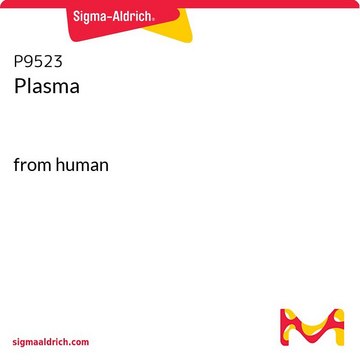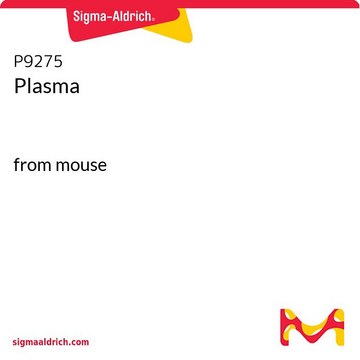P2891
Plasma
from pig
Synonym(e):
Citratplasma
Anmeldenzur Ansicht organisationsspezifischer und vertraglich vereinbarter Preise
Alle Fotos(1)
About This Item
Empfohlene Produkte
Biologische Quelle
pig
Qualitätsniveau
Form
powder
Enthält
3.8% trisodium citrate as anticoagulant
Lagertemp.
2-8°C
Suchen Sie nach ähnlichen Produkten? Aufrufen Leitfaden zum Produktvergleich
Allgemeine Beschreibung
Plasma is the liquid part of the blood and lymphatic fluid, which makes up about half of its volume. Plasma is devoid of cells and, unlike serum, has not clotted. It is prepared from whole blood that is collected with anticoagulants (9:1) and centrifuged to remove cells and cellular debris. Some of the more common proteins found in plasma are albumin and prealbumin, α1-acid glycoprotein, transferrin, lipoproteins (HDL, LDL, and VLDL), immunoglobulins, complement proteins, and coagulation proteins (thrombin, plasminogin, and fibrinogen). Citrated plasma contains citrate (3.8% trisodium citrate) as an anticoagulant.
Plasma contains a variety of proteins with diverse functions. The primary functions of the plasma proteins include the maintenance of colloid osmotic pressure, pH, and electrolyte balance; the transport of metal ions, fatty acids, steroids, hormones, and drugs to various organs of the body; use as a source for amino acids for tissue nourishment; hemostasis and the prevention of thrombosis; the regulation of cellular activity and function through hormone signaling; and defense against invasion through the actions of antibodies and complement components.
Plasma contains a variety of proteins with diverse functions. The primary functions of the plasma proteins include the maintenance of colloid osmotic pressure, pH, and electrolyte balance; the transport of metal ions, fatty acids, steroids, hormones, and drugs to various organs of the body; use as a source for amino acids for tissue nourishment; hemostasis and the prevention of thrombosis; the regulation of cellular activity and function through hormone signaling; and defense against invasion through the actions of antibodies and complement components.
Anwendung
Plasma was used as a negative control to analyze porcine immunoglobulins in diets and faeces, using a modified radial immunodiffusion method.
Sonstige Hinweise
This product is prepared from pooled porcine blood. It contains 3.8% trisodium citrate as an anticoagulant. It is tested for clotting, which indicates that the clotting factors in the product are active. However, it is not analyzed to determine whether other enzymes present are native or denatured. The resulting plasma is 0.45 microm filtered and lyophilized from the indicated volume.
Angaben zur Herstellung
Whole blood collected with anticoagulants (9:1), pooled, and centrifuged. The resulting plasma is 0.45 μm filtered and lyophilized from the indicated volumes.
Lagerklassenschlüssel
11 - Combustible Solids
WGK
WGK 3
Flammpunkt (°F)
Not applicable
Flammpunkt (°C)
Not applicable
Analysenzertifikate (COA)
Suchen Sie nach Analysenzertifikate (COA), indem Sie die Lot-/Chargennummer des Produkts eingeben. Lot- und Chargennummern sind auf dem Produktetikett hinter den Wörtern ‘Lot’ oder ‘Batch’ (Lot oder Charge) zu finden.
Besitzen Sie dieses Produkt bereits?
In der Dokumentenbibliothek finden Sie die Dokumentation zu den Produkten, die Sie kürzlich erworben haben.
Kunden haben sich ebenfalls angesehen
Porcine immunoglobulins survival in the intestinal tract of adult dogs and cats fed dry food kibbles containing spray-dried porcine plasma (SDPP) or porcine immunoglobulin concentrate (PIC)
Rodriguez C, et al.
Korean journal for food science of animal resources, 139(3-4), 201-211 (2007)
A I Potapovich et al.
British journal of pharmacology, 158(5), 1236-1247 (2009-09-30)
The immunomodulatory effects of alpha-fetoprotein (AFP) on lymphocytes and macrophages have been described in vitro and in vivo. Recombinant forms of human AFP have been proposed as potential therapeutic entities for the treatment of autoimmune diseases. We examined the effects
Unser Team von Wissenschaftlern verfügt über Erfahrung in allen Forschungsbereichen einschließlich Life Science, Materialwissenschaften, chemischer Synthese, Chromatographie, Analytik und vielen mehr..
Setzen Sie sich mit dem technischen Dienst in Verbindung.








